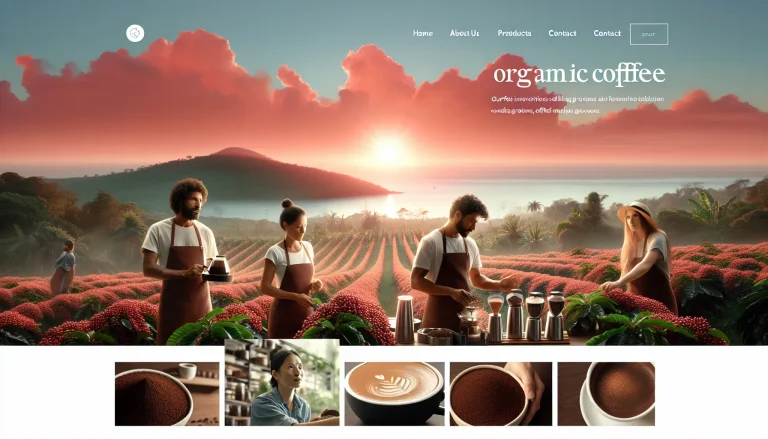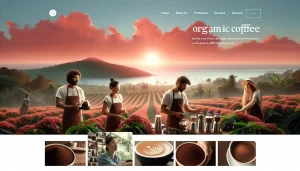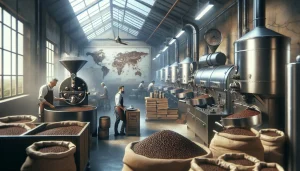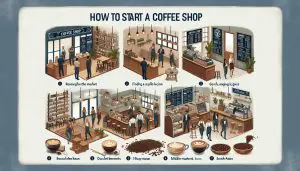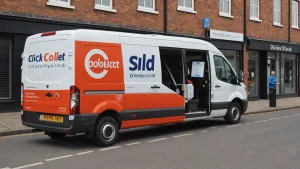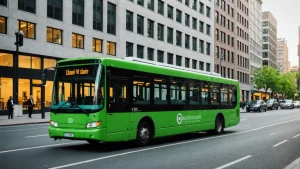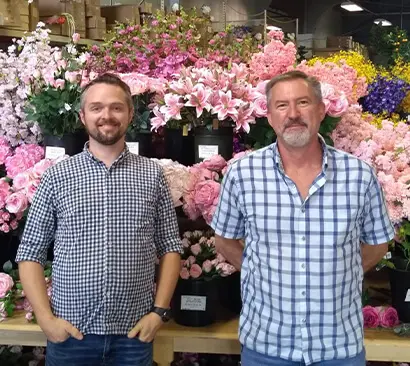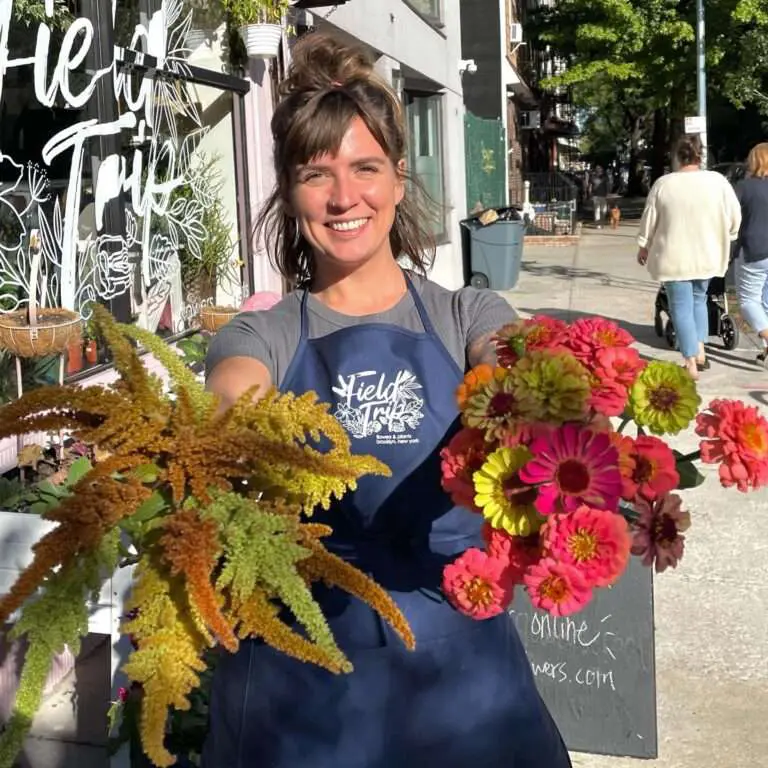In the coffee business? Step up.
By 2024, having an online presence in the coffee industry is not just an option but a necessity. This is not chitchat, it’s reality. Fact: Over 50% of consumers find a new product or business through their online search. Your coffee business website is your shop front, your barista, your menu – it’s everything. If you’re aiming to initiate a coffee roasting business, this comprehensive guide has all you need, from selecting premium beans to establishing a captivating online presence.
And we’re here to help you out.
In this digital tour, we’ll unveil essential cafe business website features, design tips, and everything you need to captivate your customers in that crucial first digital sips. For a coffee business website that not only serves but sells, stay tuned. Because if your site can’t brew interest, you’re just serving lukewarm leftovers in a business that’s brewing hot.
Coffee Consumption by Age Group in the U.S. 🧓☕️
In the U.S., people aged 60 and above are the most dedicated coffee drinkers, with about 72% enjoying it daily.

Metrobi has been a game changer for coffee industry.
With Metrobi, you can save 23% on delivery costs, save 80% of the time from managing deliveries, and delight your customers with delivery notifications & tracking.
How to Design a Coffee Business Website: A Step-by-Step Guide
Step 1: Understand Your Audience
While creating a successful coffee business website, the key is understanding the people who will be visiting it. Your target audience plays a significant role.
Gourmet Coffee's Rising Stars: Millennials ✨☕️
A significant 48% of millennials step up as gourmet coffee consumers.
Here’s why knowing your target audience is critical: it guides the design process, helping you make informed decisions on website layout, features, and content. The question then turns to how you can learn about your audience.
Start by doing market research. Collect data through surveys, social media analysis, and studies. Discover your audience’s preferences for website navigation, layout, language, and design.
Step 2: Choose the Right Platform
There’s a multitude of platforms available for building websites, each with its benefits and drawbacks. For a simple coffee shop or business, you need a reliable, user-friendly, and aesthetically pleasing platform.
Examining Popular Choices
Exploring some commonly used platforms could lead you to the best fit for your business. From feature-rich options like WordPress to more straightforward choices like Wix, the choice ultimately depends on your requirements.
Daily Coffee Consumption by Gender in the U.S. 👫☕️
In the US, men drink about 1.93 cups of coffee daily per person, while women have roughly 1.82 cups.
Weighing Pros and Cons
Each platform comes with a set of advantages and disadvantages. Ensure you weigh the pros and cons carefully before deciding. For instance, while one platform may be easy to use, it could lack in advanced features or scalability.
Step 3: Implement Essential Features
Your coffee business website should not only look good but also work well. Implementing essential features can significantly enhance the functionality of your site.
They should include easy navigation, clear calls to action, an online store, and perhaps, a blog section.
Step 4: Optimize for SEO
We live in a world where your online presence can make or break your business, and one of the key factors of that presence is how you rank in search engine results.
Why SEO Matters For Coffee Websites
SEO (Search Engine Optimization) isn’t just about high rankings; it’s about visibility. And for most coffee shops and businesses, this increased visibility can significantly boost sales and consumer interest.
The Starting Point of Online Journeys: Search Engines 🌐🔍
A staggering 68% of online journeys start with a search engine.
SEO Strategies For Coffee Businesses
There are several ways to optimize your website for search engines. Keywords are critical but choose them carefully – they should be relevant to your products and services. Creating engaging and useful blog content can also help with SEO. Consider local SEO too, especially if you have a physical store.
Remember: crafting a coffee business website isn’t a one-shot task, it is a constant process of evolution and optimization. Every step taken in design, content creation, and SEO strategy should be guided by an in-depth understanding of your audience.
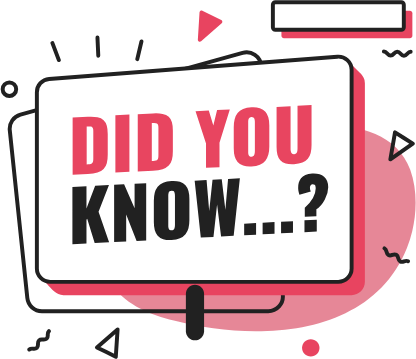
The average Metrobi driver rating is 4.97 / 5.00
Metrobi drivers are highly rated by local businesses for their professionalism and reliability, giving you peace of mind with every delivery.
Enhancing User Experience in Coffee Shop Websites
Cultivating a compelling user experience results in more engagement, higher sales, and improved brand loyalty. By focusing on enhancing user experience in your best coffee shop websites or business’ website, you can attract and retain customers with ease.
Importance of User Experience
Getting immersed in a coffee shop’s ambiance, savoring the aroma, and experiencing the subtle notes of the brew – are all integral parts of how consumers interact with your coffee roasting business. Translating this to a digital experience is crucial for business success. User experience isn’t a luxury; it’s essential if your coffee business aims to capture, engage, and retain digital customers. Enhance your digital platform and secure your initial coffee roaster clientele: discover strategies for attracting your desired customers in the bustling coffee market.
Crucially, user experience (UX) on a coffee business website has to go beyond the surface. It requires deliberately designed elements that directly and indirectly contribute to the visitors’ satisfaction. A well-curated UX can help establish a connection with the customer, one that will make them feel as comfortable as if they were settling down with their favorite cup of joe at your brick-and-mortar store. Your digital presence has to effectively cater to their online coffee-buying journey, from the first welcome, through browsing the menu to making seamless payments.
Tips for Improving User Experience
Optimizing your website’s user experience does not have to be a daunting task. With a little bit of insight and a dash of creativity, you can make your coffee business website a delightful online destination.
Streamlining Navigation
Why make it difficult for visitors to find what they’re looking for? Streamline your navigation to have a clear, concise menu that guides users effortlessly through your website. This can include a clear path to your top menu items, an easy-to-find contact page, and a straightforward checkout process.
Enhancing Visual Elements
Consumers love to see what they’re buying. High-resolution images of your coffee products and coffee blends and behind-the-scenes snaps of your coffee preparation and the brewing coffee process help build trust and set user expectations. Make this visual content easily accessible to your visitors to create an immersive, engaging experience.
Making Payments Seamless
No one wants to be stuck in an endless checkout process. Make it simple yet secure. Offer multiple payment options and ensure a logical checkout flow. Providing customers with an easy way to pay will increase your conversions and jettison any lingering purchase hesitations.
Remember, nurturing a well-thought-out user experience can prove to be a game changer for your coffee business’ website. An engaging UX leads to satisfied customers, and in turn, can help percolate your brand to great heights.
Up next is a discussion on the crucial role of mobile optimization for your coffee business site.
Why Mobile Optimization is Crucial for Your Coffee Business Website
The Rise of Mobile Browsing
Understanding the revolution of mobile browsing isn’t a tough nut to crack. People prefer their convenient little devices to access the internet over bulky personal computers. Join the dots and you’ll realize why your next top coffee shop websites or business website needs to be mobile-friendly.
The Influence of Mobile Optimization on Purchasing Behavior 📱💳
Approximately 61% of consumers are likelier to make purchases from websites optimized for mobile devices.
Once upon a time, websites were developed with the presumption of desktop browsing. Things have significantly changed since then. Mobile browsing has sprinted past desktops and currently leads the pack.
Statistics and Data on the Prevalence of Mobile Browsing
Mobiles have become the primary device for accessing the internet, thanks to their portability and convenience. The numbers back up this fact, with mobile accounting for more than half of all global web pages served.
Mobile's Share in Web Traffic 📱🌍
Over half (52.2%) of website traffic originates from mobile devices.
Small to medium-sized businesses, like coffee shops, must adapt to these trends to survive and thrive. Responsive, mobile-friendly websites have now become the new normal, sidelining the days of desktop-dominated web design.
How to Optimize Your Website for Mobile
Now that the importance of mobile optimization is crystal clear, let’s understand how to ace this game.
Step-by-step Guide on Mobile Optimization
Step 1. Responsive Web Design: Responsive design ensures your website’s look, feel, and functionality adjusts to fit any screen size, from a mobile phone to a large desktop screen.
Design Responsiveness: A Key to Retaining Visitors 📱💼
A vast majority of web designers, 73.1%, consider non-responsive design a leading cause of visitor departure from a website.
Step 2. Fast Loading Time: On mobile, more than on desktop, speed is king. Reducing your website’s loading time is crucial for keeping mobile visitors engaged.
Speed Matters: Mobile Site Performance and Conversion Rates 🚀📱
Every 0.1-second reduction in mobile site speed leads to an 8% boost in conversion rates and an 8% decrease in bounce rates.
Step 3. Optimized Media: Compress your photos, videos, and other media to ensure they load quickly and don’t bog down your website.
Step 4. Touch Friendly: Design buttons and navigation elements that are large enough to be easily accessed by a finger on a touchscreen.
Step 5. Readability and Navigation: Keep the text readable without zooming and ensure the menu is not difficult to navigate.
Personalization Wins on Mobile Platforms 📱❤️
As many as 58% of smartphone users favor businesses that personalize their mobile sites or apps based on their past interactions and preferences.
Your website is your online face to your customers, make sure it’s a face they love to see on any device.
What is a Coffee Shop Website and Why Do You Need One?
A coffee business website is not that different from other business websites. The unique aspect is that it is geared towards the promotion, selling, and showcasing of coffee-related products and services. With this online platform, you can talk all about your love for coffee, your unique coffee brewing methods, your specialized coffee products, and more. It’s your virtual coffee shop where you invite people in to explore and ultimately purchase your products. Discover insider advice and professional strategies for initiating a coffee shop venture, including the importance of a compelling online presence as part of your overall business model.
The Role of a Website in a Coffee Business
Talking about why websites are needed for a coffee business, there are numerous reasons. It starts with visibility. Having a website makes your business accessible to a broader public; it expands your business territory beyond brick-and-mortar boundaries. With user-friendly design, SEO strategies, and engaging content, it becomes a magnet for potential customers. Discover valuable insights and strategies on commencing your coffee shop business, including establishing a compelling online presence to captivate and grow your customer base.
But it’s not all about attracting customers; a website also helps with retaining them. With features like an e-commerce platform, online customer service, and loyalty programs, your website becomes a tool for building and maintaining customer relationships, making your customers feel valued and keeping them coming back for more.
Lastly, a website is a fantastic marketing tool. With blogs about coffee culture, brewing guides, promotional banners, and newsletter subscriptions, a coffee business website can inform, engage, and convert visitors to customers more effectively than traditional marketing methods.
Customer Reach and Interaction
Through websites, coffee businesses can extend their reach to potential customers worldwide. Regardless of time zones and geographical boundaries, people can visit the coffee shop website, explore the products, and make purchases. A coffee business website is also an effective platform for interacting with customers and receiving feedback. This interaction is valuable as it helps businesses understand their customers better and improve their offerings accordingly. Discovering the prime spot for your coffee shop can dramatically increase your establishment’s visibility and customer base.
Case Studies of Successful Coffee Shop Website Design
There are many success stories out there of coffee businesses using their websites as primary marketing tools. They vary from small-scale local coffee shops to large international brands. These businesses have managed to stand out by creating unique and engaging websites that resonate with their target audience while showcasing their unique coffee products and services.
Standing Out Among The Crowd
The key to a successful coffee business website is differentiation. Considering the fierce competition in the coffee industry, businesses need to offer something distinct, whether it’s their products, their story, their service, or the overall customer experience. This uniqueness should be conveyed clearly through the website design and content. It’s this factor that hooks visitors and eventually turns them into customers.
Each of the points discussed in this section forms a continuum to guide the creation of a quality coffee business website that stands out, attracts, engages, and converts. Remember, a great coffee business website isn’t accidental; it’s strategic, customer-centric, and communicates your brand effectively.
Common Mistakes to Avoid When Designing Your Coffee Business Website
Overcomplicating the Design
The design of your website should find a happy medium where it is aesthetic, yet functional. Overcomplicating the design can often lead to confusing navigation and distractions from the main content. It’s essential to maintain clean layouts and a clutter-free experience for every website visitor.
How does one actualize this? Consider the primary purpose of each webpage. What action do you want users to take? Every element on the page should serve to drive users towards that goal. Unnecessary bells and whistles can distract visitors from their primary intent – buying coffee. Every decision, from color palette to font style, should contribute to the overall user experience instead of detracting from it.
Simplicity is Key
Now simplicity doesn’t mean dull. Creativity can abound even within the most minimalist designs. It’s about making it effortless for visitors to find what they’re looking for, whether it’s the price of your single-origin beans or the opening hours of your coffee shop.
Ignoring SEO
Search engine optimization, or SEO, is a strong determinant of who visits your site – and ultimately, who drinks your coffee. Ignoring SEO is akin to opening a beautiful new coffee shop but forgetting to put up a sign outside. No matter how exquisite the interior or aromatic the brews are, potential customers must first be able to find you.
Online, SEO is your “sign”. It’s how people get directed to your website when they type “best coffee near me” or “buy coffee beans online”. It’s not enough to just exist on the internet; you must be visible too.
Investing in Mobile Optimization: Worth Every Penny 💰📱
Around 64% of SEO marketers affirm that investing in mobile optimization delivers significant returns.
Neglecting Mobile Optimization
The world is increasingly mobile – customers are browsing, ordering, and even drinking coffee on the move. If your coffee business website isn’t optimized for mobile users, you’re missing out on a significant percentage of potential customers. And it’s not just about shrinking the desktop layout. Mobile users interact differently than desktop users. For instance, the ‘click’ of a mouse converts to ‘touch’ on mobile. Ignoring this could make your site frustrating to navigate, sending potential coffee lovers bouncing off to a competitor’s site instead.
The Motivation Behind Website Redesigns: Device Responsiveness 🔄📱
Over half, 53.8% of web designers, highlight a "lack of responsiveness across all devices" as a primary motivation for website redesigns.
Brewing a Tech-Savvy Coffee Business in 2024
Understanding your target market, selecting the right design elements and features, and prioritizing mobile optimization is key to a successful coffee website design in 2024.
Why does all this matter to you? As a coffee business owner, a professionally designed website not only wins customers but also massively enhances your business reputation.
Your action plan? Start by revisiting your customer personas and evaluating the relevancy of your website’s current features then assess your website’s mobile performance.
Curious about how you can combine relevance and innovation for your coffee business’s online presence?
Remember: Your customers are as much about the experience as they are about the coffee. So, don’t just an online coffee store to build a buzz coffee or website, craft an engaging, digital coffee experience!

